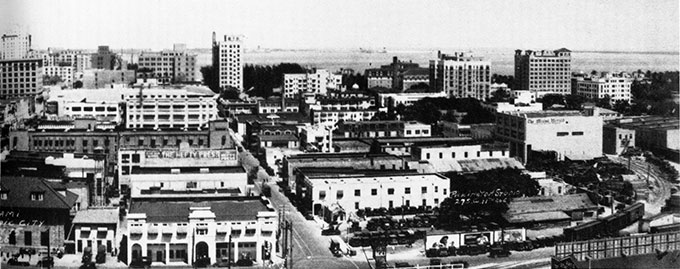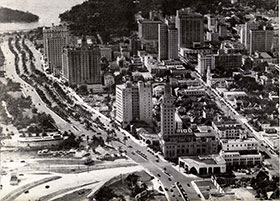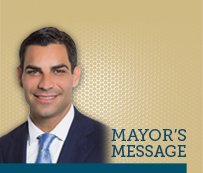
 A little more than a century ago, a city sprung up almost overnight. As a result, one of MiamiŌĆÖs many nicknames is the Magic City. Much like her geographical description, MiamiŌĆÖs history is colorful, magnetic and exotic. Ever-evolving, Miami is surging as a major international port and a gateway for global industries establishing footholds in the U.S. despite the CityŌĆÖs relatively young age.
A little more than a century ago, a city sprung up almost overnight. As a result, one of MiamiŌĆÖs many nicknames is the Magic City. Much like her geographical description, MiamiŌĆÖs history is colorful, magnetic and exotic. Ever-evolving, Miami is surging as a major international port and a gateway for global industries establishing footholds in the U.S. despite the CityŌĆÖs relatively young age.
Early inhabitants depended on the Miami River for food and spoke of their ŌĆ£MayaimiŌĆØ with pride. These early Native American settlers were known as the ŌĆ£Tequestas.ŌĆØ Later, Juan Ponce de Leon was the first European to visit in 1513 and Spain is credited for the first recorded landing in 1566. Shortly after the Spanish rule established a mission on the riverŌĆÖs north bank, the Tequestas were targeted for conversion to Christianity. The attempt failed and a majority of the tribe, disease-stricken with small pox and other illnesses died.
The attack of the United States land expansion to displace and relocate American Indians brought large migrations of Native Americans around the late 1700ŌĆÖs to South Florida. ŌĆ£CimmarronesŌĆØ as the Spanish referred to them became known as the fierce tribe called the Seminoles. After Florida was ceded to the United States and purchased from Spain in 1819, three major wars were waged by the Seminoles against the U.S. Government. The Miami area was devastated by the second ward and was known as one of the worst events in American history. These wars attributed for the slow settlement of Miami until 1842.
 Then, William English charted the ŌĆ£Village of MiamiŌĆØ and the village was established on the south bank of the Miami River. One the north side of the river, Julia Tuttle, a wealthy widow from Ohio, purchased a large citrus plantation in addition to a plot she inherited. She had envisioned the City as a gateway for international trade. This notion prompted her to persuade the millionaire Henry Flagler to extend his railroad to Miami, but he was hesitant. To aid her in her quest, Miami was hit by a severe freeze in the winter of 1894 which had no effect on her crops. This made Tuttle the sole producer of citrus that year. Tuttle along with William and Mary Brickell persuaded Flagler of the potential and agreed to give him land in exchange.
Then, William English charted the ŌĆ£Village of MiamiŌĆØ and the village was established on the south bank of the Miami River. One the north side of the river, Julia Tuttle, a wealthy widow from Ohio, purchased a large citrus plantation in addition to a plot she inherited. She had envisioned the City as a gateway for international trade. This notion prompted her to persuade the millionaire Henry Flagler to extend his railroad to Miami, but he was hesitant. To aid her in her quest, Miami was hit by a severe freeze in the winter of 1894 which had no effect on her crops. This made Tuttle the sole producer of citrus that year. Tuttle along with William and Mary Brickell persuaded Flagler of the potential and agreed to give him land in exchange.
By April 1896, the railroad tracks reached Miami and in July a meeting was held to incorporate the city. The right to vote was restricted to men and a third of the voters were Bahamian immigrants. The City was incorporated in 1896 with 444 citizens under the name of ŌĆ£The City of MiamiŌĆØ.
Along with the railroad, Flagler financed and built streets, water and power systems and a resort hotel. Canals were made to drain water from the everglades that covered a majority of the land. It was no surprise that Miami soon became an instant tourist attraction and retreat for the rich and famous. This prompted the first of many real estate booms.
Several years later John Collins and Carl Fisher, two prominent men in the CityŌĆÖs history, became promoters of Miami living. They transformed the Miami Beach area into one of the hottest tourist spots in the country. To ensure a steady influx of visitors, Collins built hotels and fisher built shops, nightclubs and the Dixie Highway. This boom lasted until one of many hurricanes in 1926 hit the area prior to the Great Depression.
The Art Deco District was born out of this era due to post hurricane re-development in the area. Also, Overtown, an area slated for African-Americans, was a hot spot for the harlem renaissance elite. Once known as ŌĆ£Little BroadwayŌĆØ head liners like Duke Ellington, Louis Armstrong, Cab Calloway and others frequented Miami Beach.

Furthermore, World War II stabilized the economy in Miami due to the hundreds of thousands of servicemen training in South Florida. The war ended and many of these servicemen returned to Miami pushing another development boom by 1950.
In 1959, the Cuban dictator Fidel Castro came to power. What followed was a mass exodus of people from Cuba to Miami. Hundreds of thousands of Cubans came to Miami thinking it to be a temporary home until their home was freed from its communistic reign. An invasion of Cuba was planned by the U.S., which became known as ŌĆ£The Bay of PigsŌĆØ, but was disrupted when the Soviet Union threatened the U.S. with warfare.
 Since the late 1960ŌĆÖs, Miami has become a mix of cultural influences. The city experience a large population growth with neighborhoods known as Little Havana, which was established with over 500,000 Cuban-Americans. Prior to this population growth, the African-American and Caribbean population made up approximately one-third of the total population. The late 1970ŌĆÖs saw yet another immigration influx when over 100,000 Haitians and Nicaraguans fled their countriesŌĆÖ newly overthrown governments. Finally, in 1980, the Mariel boatlift transported an additional 150,000 Cubans to Miami.
Since the late 1960ŌĆÖs, Miami has become a mix of cultural influences. The city experience a large population growth with neighborhoods known as Little Havana, which was established with over 500,000 Cuban-Americans. Prior to this population growth, the African-American and Caribbean population made up approximately one-third of the total population. The late 1970ŌĆÖs saw yet another immigration influx when over 100,000 Haitians and Nicaraguans fled their countriesŌĆÖ newly overthrown governments. Finally, in 1980, the Mariel boatlift transported an additional 150,000 Cubans to Miami.
With a continuing vision on global economies, Miami has become the headquarters for many multi-national companies and financial institutions. The City has the largest concentration of international banks in the country. It is also known as an attractive location for the rich and famous, but consistently ranks as one of the top poorest cities in the country.
For FY 2014-15, challenges remain. The cost of pension plans continues to increase from one year to the next as the pension plan portfolioŌĆÖs performance is stabilized. The cost of worker compensation and regulatory concerns related to the Affordable Health Care Act, and various post-employment benefits liability reporting requirements also pose a challenge. Capital improvements needs continue to increase as the City has deferred maintenance, vehicle purchases, and other capital expenditures.
Implementation of the living wage, future collective bargaining agreements, outstanding legal cases, and environmental remediation also are causes for concern. The Administration is continuing to work with all stakeholders to reach solutions that will be sustainable while meeting demands for increased service levels in public safety and building planning and construction.
The future for the City of Miami is cautiously optimistic. The Greater Miami Visitors and Convention Bureau has released data that shows greater numbers of visitors arriving through the CityŌĆÖs ports, higher hotel room occupancy rates, and more dollars being spent on food and beverage in our restaurants. Additionally, the taxable property values grew 7.8 percent in 2014; this was the third year with an increase after the real estate crash of 2008. This reversal of property value trend along with the visible increase in construction planning and permitting activity in the City, points to the recovery in the CityŌĆÖs economy.
Source: City of Miami Proposed Operating Budget Fiscal Year 2014-15


















